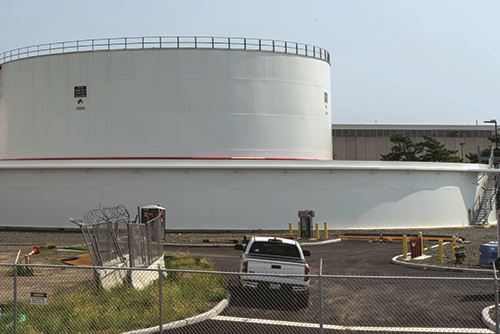Beatlemania, bell bottoms and lava lamps. These were all the rage in the ’60s, when most of the bulk fuel farm at John F. Kennedy International Airport (JFK) was built. It contains 62 tanks varying from 250,000 to 500,000 gallons each because it was designed for the way airlines worked at the time, with different grades of jet fuel and fuels with different tax status stored separately. But today, with comingled fuel and improved metering technology, the fuel farm is just as outdated as bell bottoms.
Beatlemania, bell bottoms and lava lamps. These were all the rage in the ’60s, when most of the bulk fuel farm at John F. Kennedy International Airport (JFK) was built. It contains 62 tanks varying from 250,000 to 500,000 gallons each because it was designed for the way airlines worked at the time, with different grades of jet fuel and fuels with different tax status stored separately.
 But today, with comingled fuel and improved metering technology, the fuel farm is just as outdated as bell bottoms. Plus, with the average (pre-pandemic) demand for fuel at JFK exceeding 4.8 million to 5 million gallons per day, the tank farm was struggling to satisfy demand during peak periods.
But today, with comingled fuel and improved metering technology, the fuel farm is just as outdated as bell bottoms. Plus, with the average (pre-pandemic) demand for fuel at JFK exceeding 4.8 million to 5 million gallons per day, the tank farm was struggling to satisfy demand during peak periods.
So in 2012, the Port Authority of New York and New Jersey (PANYNJ) and the airlines collaborated on a long-term plan to modernize the fuel system. Because the older tanks required more effort to operate, the strategy was to upgrade the size of the tanks so there would be fewer tanks to manage. This would make the tank farm more cost-efficient to operate while adding storage capacity for future growth.
|
facts&figures Project: 2 New Aboveground Fuel Storage Tanks Location: John F. Kennedy Int’l Airport Site: Bulk Fuel Storage Farm Airport Owner: Port Authority of New York & New Jersey Fueling Consortium: JFK Fuel Infrastructure LLC Nominal Capacity: 81,240 barrels (about 3.4 million gallons) per tank Configuration: American Petroleum Institute 650 tanks with suctions, fixed frangible roofs & steel secondary containment Project Cost: $43.5 million Timeline: Construction began in Feb. 2019; completion anticipated in Oct. 2020 New Total Capacity at Bulk Farm: 35.8 million gallons Project Manager: Argus Consulting Engineers, P.C. Design Engineers (Civil/Electrical/Instrumentation & Controls/Mechanical): Argus Consulting Engineers, P.C. Fuel Farm Manager/Operator: Allied Aviation General Contractor: Meccon Industries Inc. Tank Manufacturer: Chicago Bridge & Iron Overfill Protection System: Automatic Overfill Protection System (AOPS), with independent mechanical high-level shutoff switch
Geotechnical Engineering: Structural Engineer: Thomas F. Heausler, P.E. Corrosion Protection Engineering: EN Engineering Tank Gauging System: ENRAF Servo Gauge System & Temperature Probe Work Scope: Construction of 2 aboveground storage tanks at the bulk fuel farm, including pile foundations; steel containment & fuel, fire protection; civil; electrical power; communications & cathodic protection infrastructure to support tank operation & maintenance; site & roadway modifications/improvements Next Step: Install 2 more 3.4-million-gallon tanks Long-Term Plan: Remove existing smaller tanks & install 5-7 more 3.4-million-gallon tanks |
To execute the plan, the airlines began by forming a consortium called JFK Fuel Infrastructure LLC. Consortium Chair Matt O’Mahoney explains that this allowed the airlines to finance the project and to retain project management and engineering services. “The way it was structured, from a commercial and financial standpoint, was very advantageous for the airlines.”
The consortium contracted Argus Consulting, the largest U.S. based aviation fuel design and project management firm, for concept development; final design; permitting, bid and award assistance; construction administration and resident representation services. Argus developed a $43.5 million plan to build two 3.4 million-gallon tanks, each with a secondary containment. Construction started in February 2019 and was slated to end in October 2020. But that was really just the beginning.
The longer-term plan also calls for further modernization, including demolition of the existing smaller tanks and the addition of seven to nine more 3.4 million-gallon tanks within the footprint of the bulk fuel farm.
2 New Tanks
Prior to construction, the project team spent six to nine months securing approval for the construction under the PANYNJ building permit process, completing an Environmental Assessment under the National Environmental Policy Act and receiving clearance from the New York State Department of Environmental Conservation.
To minimize risks and reduce delays, Argus began construction on an existing brownfield site that the Port Authority had been using to stage debris from runway construction projects. The site was far enough away from the existing tanks that a planned second set of tanks can be constructed adjacent to these tanks without the need to demolish any of the existing tanks. “That means we can eventually construct four 3.4-million-gallon tanks without reducing the existing capacity of the bulk fuel farm,” explains Paul Johnke, director of New York operations for Argus. “This approach eliminates the risk of an issue arising during construction causing the new tanks to not come into service as planned, reducing the overall capacity of the bulk fuel farm.”
The two new tanks are each 110 feet in diameter and 48 feet tall with 16-foot high containment walls nearly twice the diameter of the tanks. Because the site had poor soil quality, Argus’ geotechnical design called for 293 piles per tank—each pile approximately 60 feet long—to provide a firm foundation for the tanks. A pile cap was cast on top of the piles and integrated into the concrete to support the tanks.
Crews erected the tanks ring by ring out of panels that were 30 to 40 feet long and 10 feet tall. With all five rings in place, the tanks stand 48 feet high. Because of their diameter, a center column supports rafters that in turn support the steel roof plates.
The project also added a fire protection building with firefighting foam and a water deluge system. The existing access road to a guard post was relocated, and an access road to the tanks was provided for maintenance vehicles and fire equipment.
A Wrinkle in the Plans
Construction moved along according to plan until Halloween night 2019, when the New York area experienced a severe nor’easter type storm with very high winds. Tank 2’s shell, which was about three-quarters complete, experienced a blow-in that partially collapsed the tank into a shape that resembled the Bird’s Nest, the iconic curved stadium from the Beijing Olympics. Johnke notes that although the tank erector had braced the tank to prevent a blow-in, the winds experienced that night significantly exceeded what was anticipated.

The next morning Argus and construction contractor Meccon quickly went into recovery mode with a three-step plan:
1. Stabilize the tank so it would be safe to enter.
2. Assess the level of damage and identify which plates needed to be replaced and what could be repaired.
3. Repair and replace what was damaged so that construction could continue.

“At the time of the blow-in, there were four shell rings in place, with the fourth ring not yet totally welded in,” Johnke recalls. “So the amount of damage was limited, but it did cause us to have to go back and perform rework to bring the tank back to the point where we were at before the blow-in.”
The repairs created a six- to eight-week lag in the schedule, but the damage was classified as an “act of God” by the contractor’s insurance company and all associated costs were covered.
Bigger Tanks = Bigger Benefits
In early October (2020), crews were on track to complete construction by the end of the month and integrate the two new tanks into the existing fuel system infrastructure with the help of Allied Aviation, the firm that manages and operates the bulk fuel farm for the Port Authority.

O’Mahoney explains that having tanks with a larger storage capacity allows for lower operating and maintenance costs, which results in lower per gallon charges for the airlines. “This project gives us the ability to have more storage, better utilize the overall system and avoid any shortages as we grow—which was a major concern, given the trajectory of pre-COVID growth of gallons consumed at JFK. We simply didn’t have the fuel storage.”
Both JFK and LaGuardia Airport (LGA) are fed by the Buckeye Pipeline out of Linden, NJ. So if something were to go wrong with the pipeline, both airports could have a major fuel shortage. ”It’s so much better to have that additional storage on site so you can more effectively and efficiently schedule the pipeline batches into the airport,” O’Mahoney says. “It secures the fuel supply into JFK for several years to come. And the modernization with the bigger tanks is the right way to go because it’s also more cost-effective for maintenance.”
Transferring Fuel Tank Ownership
After construction is complete, ownership of the new tanks will be transferred from the airline consortium to the Port Authority, and Allied Aviation will operate them as part of the existing bulk fuel farm.
Johnke notes that this arrangement is not the norm. “The most common model in the U.S. is that the airlines form a consortium, build the fuel system, and then own and operate it on property leased from the airport. In this case, the airport owns and operates the fuel system. There aren’t that many locations where that actually happens.”
JFK Fuel Infrastructure obtained a loan to pay for construction of the project. When the tanks are turned over to PANYNJ, the consortium will recover its loan costs through gallonage fees that are levied based on throughput at the bulk farm.
“The Port Authority owns the rest of the tank farm, so being able to construct these tanks but then have them linked in with the rest of the fuel system that is owned by the Port Authority seemed to be the most practical approach,” says O’Mahoney.
Future Plans
Looking ahead, the bulk fuel farm’s 62 existing tanks and the two new tanks will provide the airport 35.8 million gallons of on-site fuel storage. Next up, the plan calls for the addition of two more 3.4-million-gallon tanks adjacent to the tanks under construction, and eventually five to seven others. Johnke explains that all the new tanks will be concentrated in one area so that as older tanks are eventually demolished, the tank farm will become smaller. This will make the farm easier to maintain and free up areas for other airport tenants, he explains.
In addition to its bulk fuel farm, JFK also has a satellite fuel farm that receives fuel from the bulk facility through a transmission system. From the satellite fuel farm, fuel is pumped through the north and south periphery distribution mains to the individual airline terminals, where Allied uses inground hydrant systems to refuel aircraft at the terminal gates. If the larger plan evolves as expected, the satellite farm will eventually be demolished and fuel will be pumped through a new set of transmission mains from the bulk fuel farm directly to the terminals.
According to O’Mahoney, no timelines have been set for later phases, and the master plan is currently undergoing a standard review process. Regardless of how the master plan evolves, the recent tank project provides a jump-start on future improvements. “Having this project as a model of modernized tanks could allow us to ‘copy and paste’ that into a couple locations where it fits in with the master plan,” he remarks.
Cooperation & Collaboration
Other than the blow-in, Johnke and O’Mahoney both say the project went relatively smoothly due to the team’s experience, expertise and effective working relationships.
Argus and Meccon have worked together on various projects at JFK for more than 20 years, and both specialize in fueling infrastructure. Johnke notes that Argus has a good network with Meccon’s project teams and executive management. “It’s been a very close and collaborative situation with the contractor,” he comments. In addition, Johnke’s previous years working for PANYNJ helped the team navigate the Port Authority’s complex permitting process.
O’Mahoney cites teamwork as a key ingredient as well, particularly the consortium’s partnerships with the Port Authority and Argus. He also credits the Port Authority for providing flexibility for the consortium to manage the project and raise the funding, and for providing good oversight to the team during the project. “Those were the keys to success,” O’Mahoney reflects. “There’s a lot we can hopefully leverage from this good experience for future work that needs to get done at JFK.”



